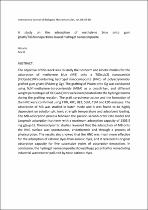 ResearchSpace
ResearchSpace
A study on the adsorption of methylene blue onto gum ghatti/TiO2nanoparticles-based hydrogel nanocomposite
JavaScript is disabled for your browser. Some features of this site may not work without it.
- ResearchSpace
- →
- Research Publications/Outputs
- →
- Journal Articles
- →
- View Item
| dc.contributor.author |
Mittal, Hemant

|
|
| dc.contributor.author |
Ray, Suprakas S

|
|
| dc.date.accessioned | 2017-07-28T09:38:10Z | |
| dc.date.available | 2017-07-28T09:38:10Z | |
| dc.date.issued | 2016-07 | |
| dc.identifier.citation | Mittal, H. and Ray, S.S. 2016. A study on the adsorption of methylene blue onto gum ghatti/TiO2nanoparticles-based hydrogel nanocomposite. International Journal of Biological Macromolecules, vol. 88: 66-80. doi.org/10.1016/j.ijbiomac.2016.03.032 | en_US |
| dc.identifier.issn | 0141-8130 | |
| dc.identifier.uri | doi.org/10.1016/j.ijbiomac.2016.03.032 | |
| dc.identifier.uri | http://www.sciencedirect.com/science/article/pii/S0141813016302562 | |
| dc.identifier.uri | http://hdl.handle.net/10204/9422 | |
| dc.description | Copyright: 2016 Elsevier. Due to copyright restrictions, the attached PDF file only contains the abstract of the full text item. For access to the full text item, kindly consult the publisher's website. | en_US |
| dc.description.abstract | The objective of this work was to study the isotherm and kinetic models for the adsorption of methylene blue (MB) onto a TiO(sub2) nanoparticle (TiO(sub2)NP)-containing hydrogel nanocomposite (HNC) of polyacrylamide-grafted gum ghatti (PAAm-g-Gg). The grafting of PAAm onto Gg was conducted using N,N’-methylene-bis-acrylamide (MBA) as a crosslinker, and different weight percentages of TiO(sub2)NPs were incorporated into the hydrogel matrix during the grafting reaction. The graft co-polymerization and the formation of the HNC were confirmed using FTIR, XRD, BET, SEM, TEM and EDS analyses. The adsorption of MB was studied in batch mode and it was found to be highly dependent on solution pH, ionic strength temperature and adsorbent loading. The MB-adsorption process followed the pseudo-second-order rate model and Langmuir adsorption isotherm with a maximum adsorption capacity of 1305.5 mg g(sup-1). Thermodynamic studies revealed that the adsorption of MB onto the HNC surface was spontaneous, endothermic and through a process of physisorption. The results also showed that the HNC was much more effective for the adsorption of cationic dyes than anionic dyes, and it retained its original adsorption capacity for five successive cycles of adsorption-desorption. In conclusion, the hydrogel nanocomposite showed huge potential for remediating industrial wastewater polluted by toxic cationic dyes. | en_US |
| dc.language.iso | en | en_US |
| dc.publisher | Elsevier | en_US |
| dc.relation.ispartofseries | Worklist;18411 | |
| dc.subject | Polyacrylamide-grafted gum ghatti | en_US |
| dc.subject | Hydrogel nanocomposite | en_US |
| dc.subject | Methylene blue | en_US |
| dc.subject | Adsorption kinetics and isotherms | en_US |
| dc.title | A study on the adsorption of methylene blue onto gum ghatti/TiO2nanoparticles-based hydrogel nanocomposite | en_US |
| dc.type | Article | en_US |
| dc.identifier.apacitation | Mittal, H., & Ray, S. S. (2016). A study on the adsorption of methylene blue onto gum ghatti/TiO2nanoparticles-based hydrogel nanocomposite. http://hdl.handle.net/10204/9422 | en_ZA |
| dc.identifier.chicagocitation | Mittal, Hemant, and Suprakas S Ray "A study on the adsorption of methylene blue onto gum ghatti/TiO2nanoparticles-based hydrogel nanocomposite." (2016) http://hdl.handle.net/10204/9422 | en_ZA |
| dc.identifier.vancouvercitation | Mittal H, Ray SS. A study on the adsorption of methylene blue onto gum ghatti/TiO2nanoparticles-based hydrogel nanocomposite. 2016; http://hdl.handle.net/10204/9422. | en_ZA |
| dc.identifier.ris | TY - Article AU - Mittal, Hemant AU - Ray, Suprakas S AB - The objective of this work was to study the isotherm and kinetic models for the adsorption of methylene blue (MB) onto a TiO(sub2) nanoparticle (TiO(sub2)NP)-containing hydrogel nanocomposite (HNC) of polyacrylamide-grafted gum ghatti (PAAm-g-Gg). The grafting of PAAm onto Gg was conducted using N,N’-methylene-bis-acrylamide (MBA) as a crosslinker, and different weight percentages of TiO(sub2)NPs were incorporated into the hydrogel matrix during the grafting reaction. The graft co-polymerization and the formation of the HNC were confirmed using FTIR, XRD, BET, SEM, TEM and EDS analyses. The adsorption of MB was studied in batch mode and it was found to be highly dependent on solution pH, ionic strength temperature and adsorbent loading. The MB-adsorption process followed the pseudo-second-order rate model and Langmuir adsorption isotherm with a maximum adsorption capacity of 1305.5 mg g(sup-1). Thermodynamic studies revealed that the adsorption of MB onto the HNC surface was spontaneous, endothermic and through a process of physisorption. The results also showed that the HNC was much more effective for the adsorption of cationic dyes than anionic dyes, and it retained its original adsorption capacity for five successive cycles of adsorption-desorption. In conclusion, the hydrogel nanocomposite showed huge potential for remediating industrial wastewater polluted by toxic cationic dyes. DA - 2016-07 DB - ResearchSpace DP - CSIR KW - Polyacrylamide-grafted gum ghatti KW - Hydrogel nanocomposite KW - Methylene blue KW - Adsorption kinetics and isotherms LK - https://researchspace.csir.co.za PY - 2016 SM - 0141-8130 T1 - A study on the adsorption of methylene blue onto gum ghatti/TiO2nanoparticles-based hydrogel nanocomposite TI - A study on the adsorption of methylene blue onto gum ghatti/TiO2nanoparticles-based hydrogel nanocomposite UR - http://hdl.handle.net/10204/9422 ER - | en_ZA |





